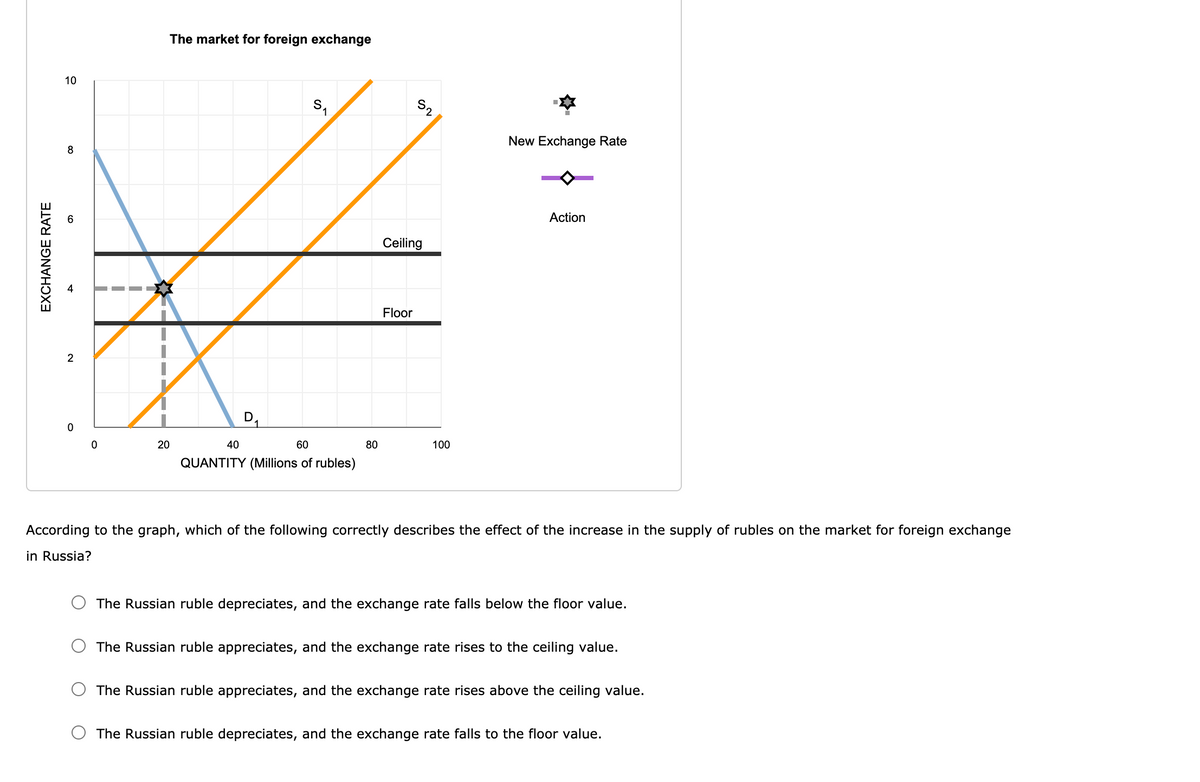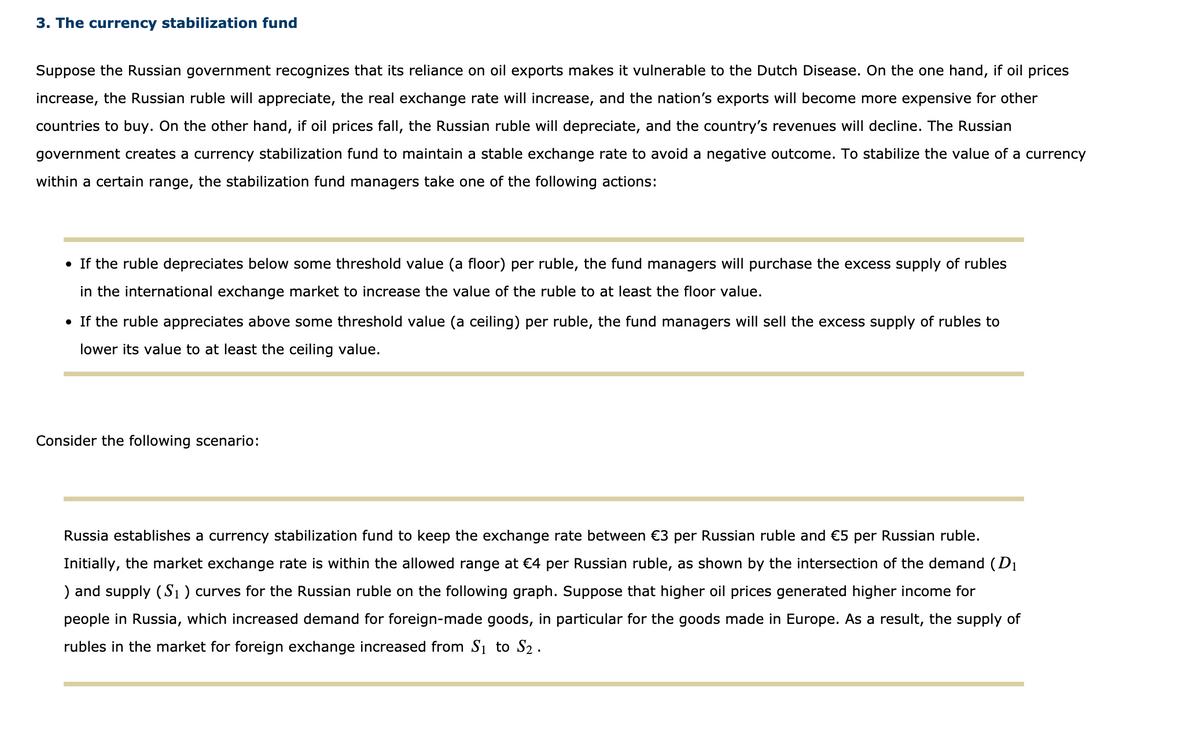On the previous graph, use the purple line (diamond symbol) to show how the stabilization fund managers have to adjust the value of the Russian ruble to ensure it meets the official requirement. (Hint: You need to draw either a new supply curve or a new demand curve. Make sure the new curve is parallel to the given supply or demand curve. Position your cursor over the given curves to see their slopes.) The managers will effectively million rubles.
On the previous graph, use the purple line (diamond symbol) to show how the stabilization fund managers have to adjust the value of the Russian ruble to ensure it meets the official requirement. (Hint: You need to draw either a new supply curve or a new demand curve. Make sure the new curve is parallel to the given supply or demand curve. Position your cursor over the given curves to see their slopes.) The managers will effectively million rubles.
Brief Principles of Macroeconomics (MindTap Course List)
8th Edition
ISBN:9781337091985
Author:N. Gregory Mankiw
Publisher:N. Gregory Mankiw
Chapter13: Open-economy Macroeconomics: Basic Concepts
Section: Chapter Questions
Problem 8PA
Related questions
Question
On the previous graph, use the purple line (diamond symbol) to show how the stabilization fund managers have to adjust the value of the Russian ruble to ensure it meets the official requirement. (Hint: You need to draw either a new supply curve or a new demand curve. Make sure the new curve is parallel to the given supply or demand curve. Position your cursor over the given curves to see their slopes.)
The managers will effectively
million rubles.

Transcribed Image Text:The market for foreign exchange
10
らへ
New Exchange Rate
8
Action
Ceiling
Floor
D.
40
60
80
100
20
QUANTITY (Millions of rubles)
According to the graph, which of the following correctly describes the effect of the increase in the supply of rubles on the market for foreign exchange
in Russia?
The Russian ruble depreciates, and the exchange rate falls below the floor value.
The Russian ruble appreciates, and the exchange rate rises to the ceiling value.
The Russian ruble appreciates, and the exchange rate rises above the ceiling value.
The Russian ruble depreciates, and the exchange rate falls to the floor value.
EXCHANGE RATE

Transcribed Image Text:3. The currency stabilization fund
Suppose the Russian government recognizes that its reliance on oil exports makes it vulnerable to the Dutch Disease. On the one hand, if oil prices
increase, the Russian ruble will appreciate, the real exchange rate will increase, and the nation's exports will become more expensive for other
countries to buy. On the other hand, if oil prices fall, the Russian ruble will depreciate, and the country's revenues will decline. The Russian
government creates a currency stabilization fund to maintain a stable exchange rate to avoid a negative outcome. To stabilize the value of a currency
within a certain range, the stabilization fund managers take one of the following actions:
• If the ruble depreciates below some threshold value (a floor) per ruble, the fund managers will purchase the excess supply of rubles
in the international exchange market to increase the value of the ruble to at least the floor value.
• If the ruble appreciates above some threshold value (a ceiling) per ruble, the fund managers will sell the excess supply of rubles to
lower its value to at least the ceiling value.
Consider the following scenario:
Russia establishes a currency stabilization fund to keep the exchange rate between €3 per Russian ruble and €5 per Russian ruble.
Initially, the market exchange rate is within the allowed range at €4 per Russian ruble, as shown by the intersection of the demand (D1
) and supply (S1) curves for the Russian ruble on the following graph. Suppose that higher oil prices generated higher income for
people in Russia, which increased demand for foreign-made goods, in particular for the goods made in Europe. As a result, the supply of
rubles in the market for foreign exchange increased from Si to S2 .
Expert Solution
This question has been solved!
Explore an expertly crafted, step-by-step solution for a thorough understanding of key concepts.
This is a popular solution!
Trending now
This is a popular solution!
Step by step
Solved in 2 steps with 1 images

Knowledge Booster
Learn more about
Need a deep-dive on the concept behind this application? Look no further. Learn more about this topic, economics and related others by exploring similar questions and additional content below.Recommended textbooks for you

Brief Principles of Macroeconomics (MindTap Cours…
Economics
ISBN:
9781337091985
Author:
N. Gregory Mankiw
Publisher:
Cengage Learning

Principles of Economics (MindTap Course List)
Economics
ISBN:
9781305585126
Author:
N. Gregory Mankiw
Publisher:
Cengage Learning

Principles of Macroeconomics (MindTap Course List)
Economics
ISBN:
9781305971509
Author:
N. Gregory Mankiw
Publisher:
Cengage Learning

Brief Principles of Macroeconomics (MindTap Cours…
Economics
ISBN:
9781337091985
Author:
N. Gregory Mankiw
Publisher:
Cengage Learning

Principles of Economics (MindTap Course List)
Economics
ISBN:
9781305585126
Author:
N. Gregory Mankiw
Publisher:
Cengage Learning

Principles of Macroeconomics (MindTap Course List)
Economics
ISBN:
9781305971509
Author:
N. Gregory Mankiw
Publisher:
Cengage Learning

Principles of Macroeconomics (MindTap Course List)
Economics
ISBN:
9781285165912
Author:
N. Gregory Mankiw
Publisher:
Cengage Learning

Principles of Economics, 7th Edition (MindTap Cou…
Economics
ISBN:
9781285165875
Author:
N. Gregory Mankiw
Publisher:
Cengage Learning

Principles of Economics 2e
Economics
ISBN:
9781947172364
Author:
Steven A. Greenlaw; David Shapiro
Publisher:
OpenStax